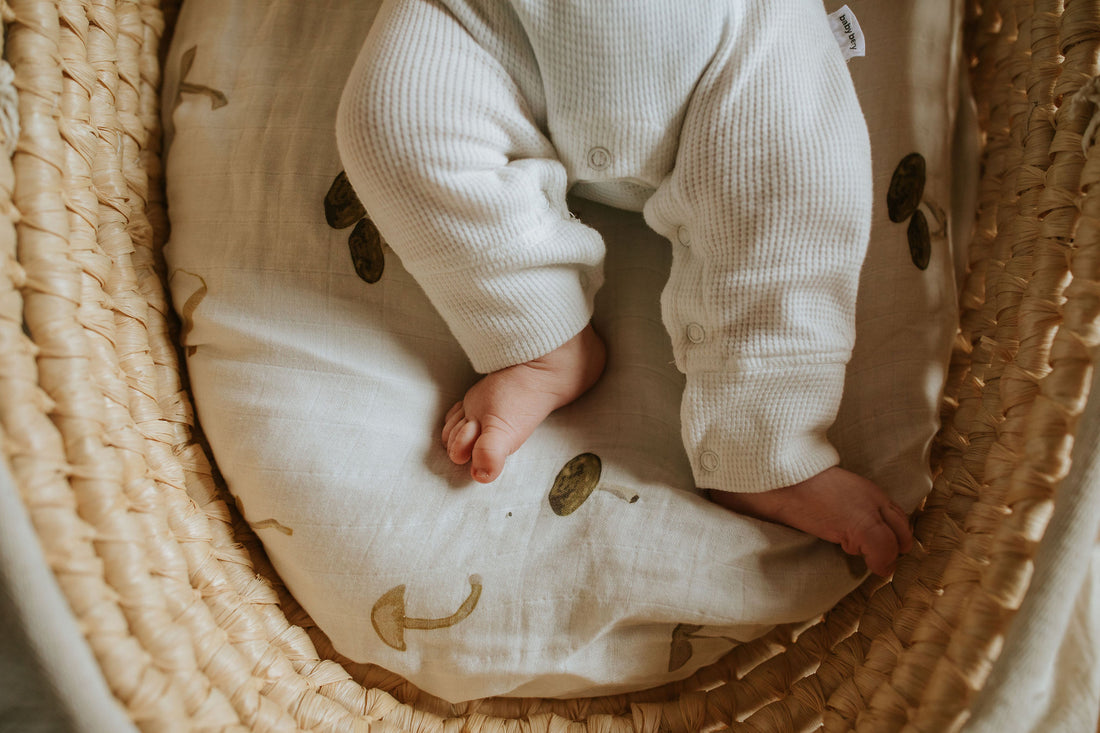
Top tips for newborn sleep
Share

We asked the wonderful Cat of Inspired Sleep to shed some light on that hazy phase – the fourth trimester. How does infant sleep work and how can we navigate this wild ride? Here's what she had to share.
So how does sleep work?!
Sleep cycles are super erratic for a newborn, and this is normal. The newborn sleep cycle varies between 20-40 minutes and roughly around 3-6 months the first Sleep Progression occurs which can make sleep wobbly and while it may not feel like it at the time, this shows that your littles brain is doing what it is meant to be doing. Essentially the brain is re-wiring HOW it goes to sleep and is maturing to connect deeper sleep cycles together.
There are two main sleep cycles that help us to achieve precious shut eye and they are REM (Rapid Eye Movement) and NREM (Non-Rapid Eye Movement) sleep.
Newborns spend 80% of their sleep in what’s called REM sleep (Rapid Eye Movement) and this is because of survival. REM sleep is often described as ‘light sleep’ and it’s not far wrong because we are all easily roused when in this sleep cycle. REM sleep is crucial for memory processing and supporting the rapid growth of neuropathways in the brain.
NREM sleep is comprised of four stages and the easiest way to interpret this, when moving between stage 1-4 is comparing it to that of driving a manual car. As you ‘shift gear’ from stage 1-4 sleep gets deeper at stage 3/4 because Delta Waves are pulsating their way through the brain. Delta waves are associated with deep levels of healing, relaxation, and restoration and are typically harder to wake from – hence why the aren’t great for our newborns!
9 Sweet Sleep tips for the fourth trimester (the first 3 months of your littles earthside life)
- Natural light for the win for those daytime naps – this helps your little to learn the difference between night and day.
- Keep it noisy – why?! The womb was a noisy place with the mother’s heartbeat ticking away and the flowing of her blood too. White noise or any other calming, consistent background noise is your friend.
- Soft and natural fabrics in the sleep space and on your little. Cotton, wool or linen are great options here. It’s the same when thinking about swaddles, sleep sacks and pyjamas. Natural fibres are breathable and generally feel softer against that fresh newborn skin.
- If a deep, warm bath sounds soothing for you it’s most likely the same for your little! They’ve emerged earthside from a warm aquatic environment where their skin is dry and the air is cool/hot. I recommend a bath/shower temp of 37degrees and your baby may enjoy this experience with you too. When your bodies emerge from the warm water your core body temperature drops sending powerful signals to your Circadian Rhythm (body clock), that it’s bedtime.
- Room temperature of 16-20 degrees – not too hot and not too cold!
- A distinct wind down time and a routine before naps/bedtime are great associations for sleep time coming up. Keep them short and sweet! These care moments can offer wonderful opportunities for gentle connection; think bath, massage, singing, books, feeding, swaddling. Focussing on the calm is a great tool to aid sleep.
- I am a strong advocate for no bad habits. Doing what feels right for you and your little during this postpartum time is your best parenting tool. Remember that your brain has ‘re-wired’ and credible science is telling as about Matrescence; the process of becoming a mother. It is compared to Adolescence and if you’re thinking back to when you moved through those awkward teenage years at high school, you’re doing it again now but with the added responsibility of caring for a little person. So if a particular sleep settling ‘tool’ works for you, carry on! Your sleep situ, your sleep business. Sleep only has to work for you and yours.
- Contact naps can be lifesavers! In-utero our littles were ‘held’ constantly, they were never alone. A pram or supportive sling, front pack, (backpack for later) in my personal and professional opinion is a must have! Most worldwide guidelines recommend sharing a sleep space with your little for at least 6 months. Recreating an environment of constant physical contact with some movement is again, very familiar and soothing.
- Pre-birth our littles could seek nourishment from the placenta at any time; a feast on tap and how glorious does that sound?! Their nutritional demands were met at any time which is why post-birth our newborns come face to face with thirst and hunger and often cry to have these needs met. Crying is about communication and most babies are very effective at using this
If you'd like to learn more from Cat you can find her here.
